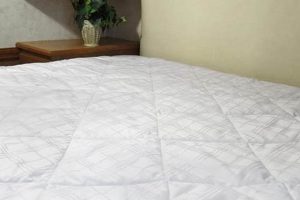The lifespan of a mattress pad is a key consideration for maintaining a clean and comfortable sleep environment. This fabric layer, placed atop the mattress, serves as a protective barrier against spills, stains, and general wear and tear. Its primary function is to extend the usability and hygiene of the underlying mattress.
Regular use of this accessory can significantly improve sleep quality and protect a considerable investment. By absorbing body oils and moisture, it helps prevent these from permeating the mattress. Historically, such layers were simple, functional textiles, but modern versions incorporate advanced materials for enhanced comfort, breathability, and even hypoallergenic properties.
Several factors influence the period of utility, including material composition, frequency of laundering, and overall care. The following sections will examine these factors in greater detail, providing a clearer understanding of when a replacement is necessary.
Extending Mattress Pad Utility
Maximizing the usable duration of a mattress pad requires consistent care and attention to specific maintenance practices.
Tip 1: Regular Laundering: Consistent washing, following the manufacturer’s instructions, is crucial. This removes accumulated body oils, dust mites, and other allergens that degrade fabric fibers over time.
Tip 2: Utilize a Mattress Protector: Layering a mattress protector beneath the pad adds an additional barrier, minimizing the amount of soil and moisture reaching the pad itself.
Tip 3: Rotate Periodically: If the pad is reversible, rotate it end-to-end every few months to distribute wear evenly across the surface.
Tip 4: Prompt Stain Removal: Address spills and stains immediately. The longer a stain sits, the harder it is to remove, potentially weakening the fabric or promoting mold growth.
Tip 5: Avoid Harsh Chemicals: When laundering, refrain from using bleach or harsh detergents, as these can damage the materials and shorten the lifespan.
Tip 6: Inspect Regularly: Periodically examine the pad for signs of wear, such as thinning, tears, or discoloration. Early detection allows for timely repairs or replacement before significant damage occurs.
Tip 7: Store Properly: When not in use, store the pad in a clean, dry place to prevent mildew and dust accumulation.
Adherence to these strategies can contribute significantly to prolonging the usefulness of the accessory, ensuring both comfort and hygiene are maintained for an extended period.
These strategies for extending mattress pad viability are essential considerations for responsible bedding management and will now lead into our concluding thoughts.
1. Material Durability
The inherent resistance of a mattress pad’s constituent materials significantly influences its overall lifespan. The choice of materials directly correlates to the item’s capacity to withstand daily use, laundering, and the general wear and tear associated with bedding.
- Fiber Strength and Density
Higher fiber strength and density in materials, such as tightly woven cotton or high-denier polyester, result in greater resistance to abrasion and tearing. This translates to a pad that maintains its integrity longer, even with regular washing and nightly use. In contrast, pads made from loosely woven, lower-density materials are more prone to premature breakdown.
- Resistance to Degradation
Materials vary in their susceptibility to degradation from factors like moisture, body oils, and cleaning agents. Some synthetics and treated natural fibers exhibit greater resilience against these elements, preserving the pad’s structural integrity and protective qualities. The selection of materials with inherent resistance to degradation directly influences the longevity of the item and its ability to continue safeguarding the underlying mattress.
- Dimensional Stability
Dimensional stability refers to a material’s ability to retain its shape and size after repeated washing or stretching. Materials with high dimensional stability prevent excessive shrinking, warping, or distortion, ensuring the pad maintains its fit and functionality throughout its lifespan. Pads constructed from materials prone to dimensional instability may become misshapen, compromising their ability to adequately protect the mattress.
In conclusion, the intrinsic properties of the materials utilized in the construction of a mattress pad are fundamental determinants of its long-term performance. Selecting pads crafted from durable, stable, and resistant materials represents a prudent investment, maximizing the usable lifespan and contributing to sustained comfort and hygiene. The interplay between these material characteristics ultimately dictates how effectively and for how long a mattress pad can fulfill its intended purpose.
2. Usage Frequency
The extent to which a mattress pad is utilized exerts a direct influence on its serviceable life. A higher rate of usage subjects the pad to increased wear and tear, thereby accelerating the deterioration process. The following points explore the specific effects of usage frequency on the lifespan of this bedding component.
- Daily vs. Occasional Use
A pad in daily use experiences continuous exposure to body oils, moisture, and friction. This constant exposure accelerates the breakdown of fibers and filling materials compared to a pad used only occasionally in a guest room. Consequently, daily-use pads necessitate more frequent laundering, which further contributes to their wear.
- Intensity of Use (Active Sleepers)
Individuals who are restless sleepers or engage in activities on the bed, such as reading or watching television, exert more stress on the pad. This elevated level of activity leads to increased abrasion and compression of the fibers, potentially reducing its effectiveness and lifespan.
- Impact on Wash Frequency
Frequent use necessitates more frequent washing to maintain hygiene and prevent the build-up of allergens. While washing is crucial for cleanliness, it also contributes to wear and tear. The increased washing cycle subjects the pad to agitation, heat, and potentially harsh detergents, all of which can degrade the materials over time.
- Stain and Spill Frequency
Higher usage often correlates with a greater likelihood of spills and stains. While immediate cleaning can mitigate the impact, repeated incidents may necessitate more aggressive cleaning methods. The chemicals used in stain removal can weaken the fibers and compromise the pad’s structural integrity, thereby reducing its lifespan.
In summation, the degree to which a mattress pad is subjected to daily use significantly shapes its durability. While frequent washing is essential for maintaining hygiene, it also contributes to material degradation. The intensity of usage, likelihood of spills, and stain occurrence all play pivotal roles in determining the period of utility for this bedding component.
3. Maintenance Practices
Maintenance practices significantly influence the serviceable duration of a mattress pad. The correlation is one of direct cause and effect; diligent adherence to recommended care protocols enhances longevity, while neglect diminishes it. This aspect is integral to estimating usefulness; regardless of initial quality, inadequate maintenance precipitates premature degradation. For example, a high-thread-count cotton pad, inherently durable, will exhibit accelerated wear if subjected to infrequent laundering or harsh cleaning agents. This underscores the imperative of employing appropriate techniques to preserve structural integrity.
Laundering frequency and method are crucial considerations. Regular washing, following manufacturer guidelines, removes accumulated body oils, sweat, and dust mites, preventing fiber breakdown and allergen accumulation. Conversely, infrequent washing fosters the proliferation of microorganisms and promotes material deterioration. The choice of detergent is equally important; harsh chemicals, such as bleach, can weaken fibers and reduce the pad’s protective qualities. Mild detergents and gentle wash cycles are recommended to minimize abrasive effects. Timely stain removal is also vital; allowing stains to set necessitates more aggressive cleaning, further stressing the fabric.
In summary, consistent and appropriate maintenance practices are fundamental to prolonging the utility of a mattress pad. Neglecting these practices, irrespective of material quality, leads to diminished performance and necessitates premature replacement. The implementation of proper laundering techniques, judicious detergent selection, and prompt stain removal collectively contribute to maximizing the investment and ensuring sustained hygiene. The challenge lies in consistently applying these practices throughout the item’s life cycle to realize its full potential lifespan.
4. Quality Standards
Quality standards exert a profound influence on the serviceable life of a mattress pad. The adherence to established quality benchmarks during manufacturing directly correlates with the durability, performance, and extended usability of the finished product. A pad produced under stringent quality controls exhibits superior resistance to wear and tear compared to one manufactured with lax standards.
For instance, a mattress pad bearing a certification from a recognized textile testing organization undergoes rigorous assessment for parameters such as fabric strength, seam integrity, and colorfastness. These pads typically employ higher-grade materials and employ enhanced construction techniques, ensuring greater resistance to degradation from washing, friction, and other common stressors. Conversely, pads lacking such certifications may utilize inferior materials and manufacturing processes, leading to premature deterioration and necessitating earlier replacement. The investment in a certified, high-quality pad typically translates to a longer lifespan and reduced replacement costs over time.
In summary, the observance of quality standards serves as a reliable indicator of a mattress pad’s potential longevity. While higher initial costs may be associated with products adhering to stringent standards, the extended lifespan and sustained performance justify the investment. Consumers benefit from increased value and a reduced frequency of replacement. Therefore, selecting pads certified by reputable organizations or brands known for their commitment to quality provides a tangible means of maximizing the product’s usable duration and protective capabilities.
5. Environmental Factors
Environmental conditions significantly influence the rate of degradation and, consequently, the usable duration of a mattress pad. Factors such as humidity, temperature, and exposure to sunlight contribute to the breakdown of fabric fibers and filling materials, affecting the item’s structural integrity and protective capabilities. A pad exposed to consistently high humidity, for instance, is more susceptible to mold and mildew growth, leading to accelerated deterioration and the potential for allergen proliferation. Similarly, prolonged exposure to direct sunlight can cause fading and weakening of the fabric, reducing its effectiveness as a barrier against spills and stains. The interplay between these environmental stressors and the materials used in the pad’s construction determines the overall pace of decline.
The location in which the mattress pad is used and stored plays a crucial role. For example, a pad used in a coastal region with high humidity and salt air will experience a shorter lifespan than one used in a drier, more temperate climate. Likewise, improper storage in damp or poorly ventilated areas promotes microbial growth and accelerates material breakdown. These external elements directly impact the rate at which the pad’s protective qualities diminish, affecting its ability to maintain hygiene and extend the lifespan of the underlying mattress. Understanding these environmental influences allows for informed decisions regarding material selection and appropriate care practices to mitigate their detrimental effects.
In summary, environmental factors represent a critical determinant of a mattress pad’s longevity. Humidity, temperature, and sunlight exposure each contribute to the gradual degradation of materials, impacting the item’s ability to protect and maintain hygiene. Recognizing these influences enables proactive measures, such as climate-controlled storage and the selection of resilient materials, to extend the pad’s serviceable duration. Ultimately, awareness of these environmental dynamics is essential for maximizing the investment in bedding and ensuring sustained comfort and cleanliness. The understanding of environmental factors as a component of “how long does a mattress pad last”, is the understanding of how to take proper measures to prevent decay.
Frequently Asked Questions
The following addresses common inquiries regarding the typical lifespan of mattress pads and factors influencing their duration of utility.
Question 1: What is the average expected lifespan of a mattress pad?
The expected lifespan typically ranges from one to five years, contingent upon material quality, usage frequency, and maintenance practices.
Question 2: How does material composition impact the longevity of a mattress pad?
Pads constructed from durable, high-quality materials, such as tightly woven cotton or resilient synthetics, generally outlast those made from less robust or lower-grade materials.
Question 3: How often should a mattress pad be laundered to maximize its lifespan?
Laundering every one to two months is generally recommended. Adherence to the manufacturer’s care instructions is c
rucial to avoid damage.
Question 4: What are the key indicators that a mattress pad needs to be replaced?
Signs indicating replacement include visible tears, thinning of the material, persistent odors, and significant staining that cannot be removed through laundering.
Question 5: Does using a mattress protector extend the lifespan of a mattress pad?
Yes, a mattress protector adds an additional layer of defense against spills, stains, and wear, effectively prolonging the usefulness of the pad.
Question 6: Can improper storage affect the lifespan of a mattress pad?
Improper storage in damp or poorly ventilated areas can promote mold and mildew growth, leading to accelerated material degradation and a reduced lifespan.
Consistent maintenance and careful attention to material composition and usage patterns are key to maximizing the period of utility. Failure to address these variables will affect the mattress pad’s lifecycle.
The subsequent section will address how choosing the right type of pad can also affect its usable life.
Determining Mattress Pad Longevity
The preceding analysis clarifies that the effective service period is not a fixed value, but rather a variable dependent on several interconnected factors. Material quality, frequency of use, maintenance protocols, adherence to quality standards during manufacturing, and environmental conditions all contribute to the overall lifespan. Attending to these elements allows for an informed assessment of when a replacement is necessary to maintain a hygienic and comfortable sleep environment.
Therefore, a proactive approach to bedding care is essential. By carefully selecting a pad constructed from durable materials, diligently adhering to recommended cleaning practices, and mitigating environmental stressors, individuals can maximize its longevity and safeguard the underlying mattress. A thoughtful investment in quality and consistent maintenance yields long-term benefits, ensuring both comfort and hygiene are sustained over an extended period.


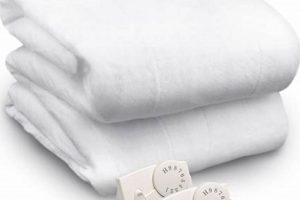
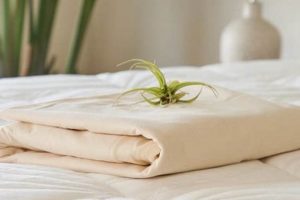
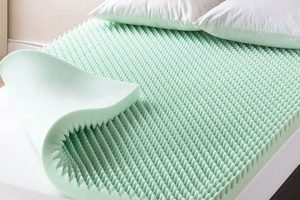
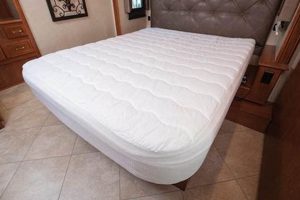
![Enhance Sleep: Best Novaform Mattress Pad [Review] Organic & Natural Mattress Buyer’s Guide: Non-Toxic Sleep Solutions Enhance Sleep: Best Novaform Mattress Pad [Review] | Organic & Natural Mattress Buyer’s Guide: Non-Toxic Sleep Solutions](https://mattressworldpa.com/wp-content/uploads/2025/07/th-4720-300x200.jpg)
